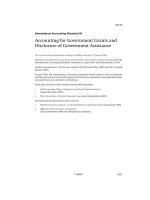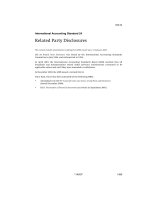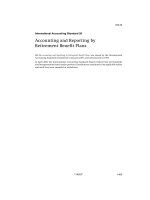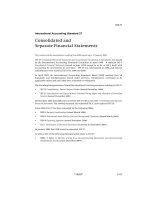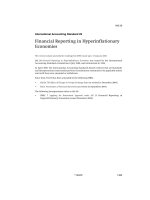chuẩn mực kế toán quốc tế ias 17 lease classification
Bạn đang xem bản rút gọn của tài liệu. Xem và tải ngay bản đầy đủ của tài liệu tại đây (80 KB, 6 trang )
IAS 17
A. Lease classification
A-1. Example – finance lease classification
Ex 1 : On 1 January 20X1 an entity entered, as lessee, into a five-year non-cancellable lease of a machine
that has an economic life of five years and nil residual value. On 1 January 20X1 (the inception of the
lease) the fair value (cash cost) of the machine is CU100,000. On 31 December for each of the first four
years of the lease term the lessee is required to pay the lessor CU23,000. At the end of the lease term,
ownership of the machine passes to the lessee upon payment of the final lease payment of CU23,539. The
interest rate implicit in the lease is 5 per cent per year. This rate approximates the lessee’s incremental
borrowing rate.
A-2. Examples – operating lease classification
Ex 2: On 1 January 20X1 an entity entered, as lessee, into a five-year non-cancellable lease of farmland
with a fair value (cash cost) of CU100,000. The lessee is required to pay the lessor CU5,000 per year.
Ex 3: On 1 January 20X1 an entity entered, as lessee, into a five-day non-cancellable lease of a motor
vehicle that has an economic life of five years and nil residual value. On 1 January 20X1 (the inception of
the lease), the fair value (cash cost) of the motor vehicle is CU100,000. The lessor charges the lessee
CU120 per day for the use of the motor vehicle. At the end of the lease term the lessee returns the motor
vehicle to the lessor.
A-3: Examples – finance lease classification
Ex 4: On 1 January 20X1 an entity entered, as lessee, into a five-year non-cancellable lease of a machine
that has an economic life of ten years, at the end of which it is expected to have no value. At the inception
of the lease, the fair value (cash cost) of the machine is CU100,000. On 31 December for each of the
first four years of the lease term the lessee is required to pay the lessor CU23,000. At the end of the lease
term ownership of the machine passes to the lessee upon payment of the final lease payment of
CU23,539. The interest rate implicit in the lease is 5 per cent per year, which approximates the lessee’s
incremental borrowing rate.
Ex 5 :The facts are the same as in example 10. However, in this example, ownership of the machine does
not automatically pass to the lessee at the end of the lease. Instead, the lease provides the lessee with an
option to acquire the machine from the lessor on 1 January 20X6 for CU1.
Ex 6 : The facts are the same as in example 10. However, in this example, the economic life of the machine
is five years and ownership of the machine does not pass to the lessee at the end of the lease.
Ex 13 : The facts are the same as in example 10. However, in this example, the leased asset is a bespoke (or
custom-made) machine that could not be used by another without major modifications.
A-3: Examples – finance lease classification
Ex 7: On 1 January 20X1 an entity enters into an indefinite period lease for the use of a machine that has an
economic life of five years and nil residual value. The lessee is required to pay the lessor CU23,000 per
year. The lessee can terminate the lease on 1 January of any year. However, termination obliges the
lessee to pay the lessor a termination penalty. The amount of the penalty depends on the date of
termination as follows:
Termination date Penalty (CU )
1 January 20X2 82,000
1 January 20X3 63,100
1 January 20X4 43,255
1 January 20X5 22,418
After 1 January 20X5 nil
At the inception of the lease, the fair value (cash cost) of the machine is CU100,000. The lessee’s
incremental borrowing rate is 5 per cent per year.
1
Ex 8 : On 1 January 20X1 an entity entered, as lessee, into a five-year non-cancellable lease of a machine
that has an economic life of ten years and nil residual value. At the inception of the lease, the fair value
(cash cost) of the machine is CU100,000. On 31 December for each of the first four years of the lease
term the lessee is required to pay the lessor CU23,000. A final lease payment of CU23,539 is due on 31
December 20X5. However, in accordance with the lease agreement, the lessee has an option to continue
the lease for a further five years at a lease payment of CU1 per year. The lessee’s incremental borrowing
rate is 5 per cent per year.
Ex 9 : On 1 January 20X1 an entity entered, as lessee, into a three-year non-cancellable lease of a motor
vehicle that has an economic life of seven years. At the inception of the lease, the fair value (cash cost)
of the motor vehicle is CU100,000. On 31 December 20X1, 20X2 and 20X3 the lessee is required to pay
the lessor CU25,000. The lessor is required to sell the motor vehicle to an independent third party at the
end of the lease term. If the motor vehicle is sold for less than CU36,950 the lessee will pay the shortfall
to the lessor. Conversely, if the motor vehicle is sold for more than CU36,950 the lessee will receive the
excess from the lessor in the form of rental rebate. The lessee’s incremental borrowing rate is 5 per cent
per year.
A-4: Examples – classification not re-evaluated
Ex 10: On 1 January 20X1 an entity entered, as lessee, into a five-year non-cancellable lease of a barge that
has an economic life of 11 years and nil residual value.
At the inception of the lease, the fair value (cash cost) of the barge is CU100,000.
On 31 December for each year of the lease term the lessee is required to pay the lessor CU15,000.
The lessee has an option to acquire the barge from the lessor on 31 December 20X5 for CU44,744 (at the
inception of the lease CU44,744 is the expected market value of the machine on 31 December 20X5).
The lessee’s incremental borrowing rate is 5 per cent per year.
In 20X2 the expected market value of the barge on 31 December 20X5 increased to CU120,000.
Ex 11 :The facts are the same as in example 17. However, in this example, on 1 January 20X1 the market
value of the barge at the end of the lease was expected to be CU100,000.
In 20X2 the expected market value of the barge on 31 December 20X5 fell to CU20,000.
Ex 12 : The facts are the same as in example 17. However, in this example, on 31 December 20X3 the
remaining expected economic life of the barge was revised to two years.
A-5. Example – classification re-evaluated
Ex 13 :The facts are the same as in example 17. However, in this example, on 31 December 20X4 the lease
was amended to replace the purchase option with the compulsory transfer of ownership of the leased
barge to the lessee in return for a payment from the lessee of CU20,000.
B. Financial statements of lessees—Financial leases
B-1. Examples – lessee—initial recognition of finance leases
Ex 14: The facts are the same as in example 10. For ease of reference the facts are repeated below.
On 1 January 20X1 an entity entered, as lessee, into a five-year non-cancellable lease of a machine that has
an economic life of ten years, at the end of which it is expected to have no value. At the inception of the
lease, the fair value (cash cost) of the machine is CU100,000.
On 31 December of each of the first four years of the lease term the lessee is required to pay the lessor
CU23,000. At the end of the lease term ownership of the machine transfers to the lessee upon payment of
the final lease payment of CU23,539.
The interest rate implicit in the lease is 5 per cent per year which approximates the lessee’s incremental
borrowing rate.
Ex 15 : The facts are the same as in example 21. However, in this example, the lessee incurred (and paid)
CU1,000 brokerage fees and legal costs in arranging the lease of the machine.
B-2. Examples – lessee—subsequent measurement of finance leases
2
Ex 16: The facts are the same as in example 10 as repeated in example 21 At the commencement of the
lease (in accordance with paragraph 20.9) the entity recognised the asset (machine) and the liability
(finance lease obligation) measured at CU100,000.
Ex 17 The facts are the same as in example 23. However, in this example, in addition to the minimum
lease payments the lessee paid CU1,000 contingent rent to the lessor on 31 December 20X1.
Ex 18 On 1 January 20X1 an entity entered, as lessee, into a five-year non-cancellable lease of a machine
that has an economic life of five and a half years, at the end of which it is expected to be worthless. At
the inception of the lease, the fair value (cash cost) of the machine is CU100,000. On 31 December for
each year of the lease term the lessee is required to pay the lessor CU23,000. At the end of the lease term
ownership of the machine passes to an independent third party upon payment of the fixed amount of
CU539. At the inception of the lease the lessee appropriately classified the lease as a finance lease.
B-3. Examples – lessee—accounting for leased assets
Note: in the examples below it is assumed that the leased assets do not have any residual value.
Ex 19 The facts are the same as in example 25.
Ex 20 On 1 January 20X1 an entity entered, as lessee, into a five-year non-cancellable finance lease of a
machine that has an economic life of five years and nil residual value.
On 1 January 20X1 (the inception of the lease) the fair value (cash cost) of the machine is CU100,000 and
the present value of the minimum lease payments (discounted at the rate implicit in the lease) is calculated
as CU105,000.
Ex 21 The facts are the same as in example 27. However, in this example, the economic life of the machine
is ten years and the entity intends using the machine for its entire economic life. The machine is expected
to be worthless at the end of its useful life. Ownership of the leased machine passes from the lessor to the
lessee at the end of the lease.
Ex 22 The facts are the same as in example 28. However, in this example, the lease provides the lessee with
an option to acquire the leased machine from the lessor at the end of the lease term for CU1.
Ex 23 On 1 January 20X1 an entity entered, as lessee, into a five-year non-cancellable finance lease of a
machine that has an economic life of four years and nil residual value.
On 1 January 20X1 (the inception of the lease) the fair value (cash cost) of the machine is CU100,000.
The entity depreciates machinery on the straight-line basis.
On 1 January 20X1 the lessee recognised the leased machine as an item of property, plant and equipment at
CU100,000.
C. Financial statements of lessees—operating leases
C-1. Examples – lessee—operating lease recognition and measurement
Ex 24 On 1 January 20X1 an entity entered, as lessee, into a two-year non-cancellable operating lease of a
photocopier. As part of that agreement the lessor agrees to provide maintenance services to the lessee in
respect of the photocopier. The agreement obliges the lessee to pay CU100 to the lessor on the last day
of each month of the lease term. It has been determined with reference to transactions between the lessor
and other parties that 20 per cent of the monthly payments are in respect of the maintenance services (ie
80 per cent of the payments are in respect of the lease).
Ex 25 The facts are the same as in example 35. However, in this example, it has been determined that
services are expected to be received of CU140 in January 20X1 and CU340 in February 20X2. In this
example the effects of discounting are ignored.
Ex 26 On 1 January 20X1 an entity entered, as lessee, into a five-year non-cancellable operating lease of a
building.
No lease amount is payable for the first four years of the lease. The single lease payment of CU5,000 is due
on 1 January 20X5.
Ex 27 The facts are the same as in example 37. However, in this example, the single lease payment of
CU5,000 is due on 1 January 20X1.
3
Ex 28 On 1 January 20X1 an entity entered into a new lease arrangement with a new lessor. The lessor
agrees to pay the lessee’s relocation costs as an incentive to the lessee for entering into the new lease.
The lessee’s moving costs are CU1,000. The new lease has a term of ten years, at a fixed rate of
CU2,000 per year.
Ex 29 On 1 January 20X1 an entity entered, as lessee, into a five-year non-cancellable operating lease of a
building.
The lease payments for the year ending 20X1 is CU100,000. Lease payments for 20X2–20X5 are
CU100,000 adjusted for expected inflation by applying the expected consumer price index, as follows:
• 20X2: CU105,000
• 20X3: CU110,250
• 20X4: CU115,763
• 20X5: CU121,551
The amounts are payable yearly in advance (ie on 1 January each year of the lease term).
D. Financial statements of lessors: finance leases
D-1. Initial recognition and measurement
Example – lessor—finance leases initial recognition
Ex 30 On 1 January 20X1 an entity acquired a machine to lease to an independent third party under a
finance lease for CU100,000. The entity immediately enters into a five-year non-cancellable lease to
transfer the right of use of a machine that has an economic life of five years and nil residual value to
another independent third party. The lessee is required to pay the entity four yearly payments of
CU23,000 and a final payment of CU23,539 payable yearly in arrears (ie on 31 December of each year).
Ownership of the machine passes to the lessee at the end of the lease term. The present value of the lease
payments discounted at the interest rate implicit in the lease is CU100,000.
Ex 31 The facts are the same as in example 45. However, in this example, the lessor incurred (and paid)
CU1,000 brokerage fees and legal costs in arranging the lease of the machine.
D-2. Example – lessor—finance leases subsequent measurement
Ex 32 The facts are the same as in example 45.
D-3. Manufacturer or dealer lessors
Example – dealer lessor—finance leases
Ex 33 The facts are the same as in example 45. However, in this example, the entity buys machines for
CU50,000 each with a view to selling them (or leasing them out under finance leases) to independent third
parties at a 100 per cent mark-up on cost.
E. Financial statements of lessors: operating leases
Recognition and measurement
Examples – lessor—operating leases
Ex 34 On 1 January 20X1 an entity acquired a machine at a cost of CU5,000. The machine has an
economic life of six years and nil residual value. On 2 January 20X1 the entity entered, as lessor, into a
two-year non-cancellable operating lease of a machine. As part of that agreement the entity agrees to
provide maintenance services to the lessee in respect of the machine.
Ex 35 On 1 January 20X1 an entity entered, as lessor, into a five-year non-cancellable operating lease of a
building it completed constructing earlier that day at a cost of CU800,000. The building has an economic
life of 60 years and nil residual value. The entity accounts for the building as property, plant and
equipment using the cost model because the fair value of the property cannot be determined reliably
without undue cost or effort on an ongoing basis. No lease amount is payable for the first four years of
the lease. The single lease payment of CU150,000 is due on 1 January 20X5.
Ex 36 The facts are the same as in example 52. However, in this example, the single lease
payment of CU150,000 is due on 1 January 20X1.
MULTIPLE-CHOICE QUESTIONS
4
1. The classification of a lease as either an operating or finance lease is based on
(a) The length of the lease.
(b) The transfer of the risks and rewards of ownership.
(c) The minimum lease payments being at least 50% of the fair value.
(d) The economic life of the asset.
2. Which of the following situations would prima facie lead to a lease being classified as an operating
lease?
(a) Transfer of ownership to the lessee at the end of the lease term.
(b) Option to purchase at a value below the fair value of the asset.
(c) The lease term is for a major part of the as-set’s life.
(d) The present value of the minimum lease payments is 50% of the fair value of the as-set.
3. The classification of a lease is normally carried out
(a) At the end of the lease term.
(b) After a “cooling off” period of one year.
(c) At the inception of the lease.
(d) When the entity deems it to be necessary.
4. Where there is a lease of land and buildings and the title to the land is not transferred, generally the lease
is treated as if
(a) The land is a finance lease, the building is a finance lease.
(b) The land is a finance lease, the building is an operating lease.
(c) The land is an operating lease, the building is a finance lease.
(d) The land is an operating lease, the building is an operating lease.
5. The lease of land and buildings when split causes difficulty in the allocation of the minimum lease
payments. In this case the minimum lease payments should be split
(a) According to the relative fair value of two elements.
(b) By the entity based on the useful life of the two elements.
(c) Using the sum of the digits method.
(d) According to any fair method devised by the entity.
Answer: (a)
6. An entity classifies a lease of land and buildings as an investment property under IAS 40. The entity has
adopted the fair value model. In this case
(a) Separate measurement of the lease of land and buildings is compulsory.
(b) Separate measurement of the lease of land and buildings is not required.
(c) The lease is treated as an operating lease.
(d) The lease cannot be treated as an operating lease.
7. Which is the correct accounting treatment for an operating lease payment in the accounts of the lessee?
(a) Dr Cash / Cr Operating lease rentals/income statement
(b) Dr Operating lease rentals/income statement / Cr Cash
(c) Dr Asset account / Cr Cash
(d) Dr Cash / Cr Asset account
8. Which is the correct accounting treatment for a finance lease in the accounts of a lessor?
(a) Treat as a noncurrent asset equal to net in-vestment in lease. Recognize all finance payments in income
statements.
(b) Treat as a receivable equal to gross amount receivable on lease. Recognize finance pay ments in cash
and by reducing debtor.
(c) Treat as a receivable equal to net investment in the lease. Recognize finance payment by reducing
debtor and taking interest to in-come statement.
(d) Treat as a receivable equal to net investment in the lease. Recognize finance payments in
5
cash and by reduction of debtor.
6



